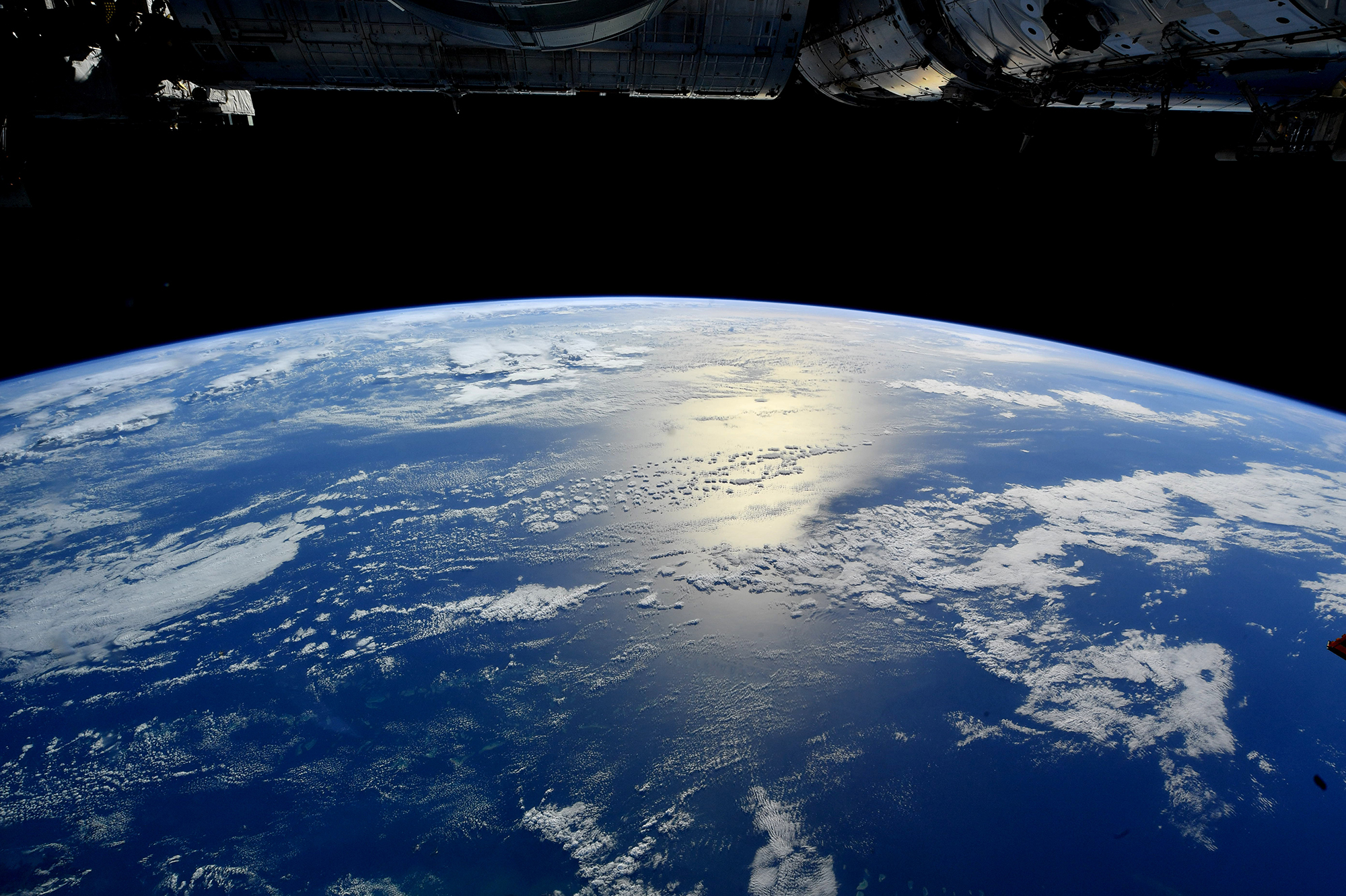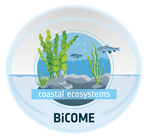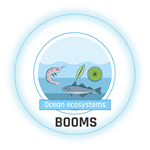Story
Monitoring marine biodiversity from space
11 April 2024
PML has worked with the European Space Agency (ESA) for a number of decades, building a strong collaborative relationship on Earth observation research.

Earth from the International Space Station | ESA/NASA-S.Cristoforetti: CC BY-NC-SA 2.0
This research relates to issues such as observing marine conditions, monitoring climate change impacts, estimating primary production, mapping harmful algal blooms, tracing water-borne diseases, detecting oil spills and marine litter, and monitoring marine biodiversity.
Monitoring marine biodiversity is vital to help us understand the health of our ocean. Generally the more biodiverse an ecosystem, the better it will be able to respond to increasing pressures and natural or human disturbances. Therefore, monitoring changes in biodiversity can help scientists assess areas of vulnerability and forecast how ecosystems, and the services they provide, may change under different scenarios.
However, there are many challenges when it comes to monitoring marine biodiversity. The ocean is a vast area so traditional direct sampling, although essential for activities such as validation purposes, only gives a limited picture of what is happening under the waves. Direct sampling is also labour intensive and expensive, given all the equipment, staff and travel required.
Advancing satellite technologies have been great at addressing these issues, giving scientists a complementary tool to their direct sampling and enabling a more global view of marine biodiversity and therefore, ocean health. This global data is also useful for developing large-scale datasets that can be analysed by experts to provide information on changes over time and trends.
ESA and PML have collaborated on the following projects to help uncover the current state of marine biodiversity, improve monitoring techniques and identify likely trends for the future.
 BiCOME (Biodiversity of the Coastal Ocean: Monitoring with Earth Observation)
BiCOME (Biodiversity of the Coastal Ocean: Monitoring with Earth Observation)
Project start: October 2021 | Project end: Summer 2024
Project funded by ESA, coordinated by PML.
Principal Investigator: Dr Victor Martinez-Vicente
Website: https://bicome.info
BiCOME will develop a better understanding of how the community structure and function of coastal ecosystems will respond to the human and natural drivers in a changing climate.
Increasing pressure on nature due to anthropogenic drivers is leading to a reduction of global biodiversity and its associated benefits at the planetary scale. In coastal environments, the most important direct drivers of biodiversity loss are: fishing, land and sea use, climate change and pollution. These drivers have accelerated in the last 50 years are predicted to continue. In order to guide further action, it is therefore urgent and important to develop “fit-for-purpose” observation tools.
These observations should be capable of assessing and monitoring how the community structure and function of coastal ecosystems will respond to the anthropogenic and natural drivers in a changing climate. This can be achieved using combination of observations of Essential Biodiversity Variables (EBVs) with environmental variables and estimates of direct drivers.
The BiCOME project will develop and demonstrate that (EBVs for scientific and monitoring applications, can be obtained from state-of-the-art remotely sensed reflectance and that they can be scalable globally. To help us gain a better understand how the community structure and function of coastal ecosystems will respond to the anthropogenic and natural drivers in a changing climate.
 BOOMS (Biodiversity in the Open Ocean: Mapping, Monitoring and Modelling)
BOOMS (Biodiversity in the Open Ocean: Mapping, Monitoring and Modelling)
Project start: February 2022 | Project end: Summer 2024
Project funded by ESA, coordinated by PML.
Principal Investigator: Dr Victor Martinez-Vicente
Website: https://booms-project.org
The BOOMS project aims to provide the best possible characterisation of oceanic seascapes (habitats defined by physical, chemical or biological characteristics), and its relationship to Essential Biodiversity Variables (EBV) globally.
Increasing pressure due to anthropogenic drivers is leading to a reduction of global biodiversity and its associated benefits at the planetary scale. In open ocean (seafloor depth greater than 200 m) the most important direct drivers of biodiversity loss is fishing and extraction of seafood, with a lesser but rapidly increasing importance of climate change, pollution and invasive species. These drivers have accelerated in the last 50 years and they are predicted to continue, despite international efforts in the last decades. To guide further action, it is therefore urgent and important to develop “fit-for-purpose” observation tools. These observations should be capable of assessing and monitoring how the community structure and function of coastal ecosystems respond to the anthropogenic and natural drivers in a changing climate.
BOOMS will produce a >10-year time series of seascapes based on 4-km resolution remote sensing data over the global ocean, combining independent datasets from advanced algorithms of ocean colour and sea surface temperature. BOOMS will focus on three Science Case Studies, for different trophic levels: phytoplankton, zooplankton and fish.
.png?width=150&height=150) HyperBOOST (Hyperspectral Bio-Optical Observations Sailing on Tara)
HyperBOOST (Hyperspectral Bio-Optical Observations Sailing on Tara)
Project start: June 2023 | Project end: June 2025
Project funded by ESA, coordinated by PML.
Principal Investigator: Dr Victor Martinez-Vicente
HyperBOOST will obtain in situ observations useful for validation of satellite products related to coastal biodiversity.
Marine ecosystem health in coastal areas can be challenging to monitor using Earth Observation due to their optical complexity. HyperBOOST will address this by using in-situ hyperspectral bio-optical measurements for the validation of satellite data, useful to develop marine coastal biodiversity products when combined with biological measurements from the TRaversing European Coastlines (TREC) expedition, co-ordinated by the European Molecular Biology Laboratory. HyperBOOST is an international collaboration between PML (UK), Consiglio Nazionale delle Ricerche (Italy), Laboratoire d'Océanographie (France) and University of Maine (USA), supported by the European Space Agency (ESA).
One of the key aspects of the project is the utilisation of the Tara schooner vessel, a ‘floating laboratory’ that is owned by the Tara Ocean Foundation, and is being utilised for its capability to provide in-situ measurements at more than 120 land-sea transects along the European coastline. Installation work has already been completed on the vessel to install in-situ sensors; a Solar tracking radiometry platform (So-Rad) and a Hyperspectral Radiometer for Global & Diffuse Irradiance.
MiTHO (Multiple Threats on Ocean Health)
Funded by ESA, coordinated by CNR-ISMAR with PML leading two work packages.Website: https://www.mitho.org/
MiTHo aims at developing innovative Earth observation (EO)-based multistressor cumulative hazard indexes, by exploiting the latest EO-based products achieved within the ESA Ocean Science cluster projects.
Combining multi-mission independent EO-based datasets, for the detection of extreme events in warming, ocean pH, winds and river inputs, and up to in-situ (BGCArgo) and modelled O2 data for hypoxia and ocean deoxygenation detection.
In the project, PML is involved with evaluating the impacts of the multi-stressor cumulative hazard indices developed within MiTHo on biodiversity components, such as the diversity in phytoplankton functional types in European continental waters, in order to support international agreements, such as OSPAR.
 In this next section, Dr Victor Martinez-Vicente answers questions on working with ESA on marine biodiversity projects and his hopes for future research in this area.
In this next section, Dr Victor Martinez-Vicente answers questions on working with ESA on marine biodiversity projects and his hopes for future research in this area.How long have you been working on projects with ESA?
“I arrived at PML some 20 years ago and, as a Junior scientist, I was involved in several in situ sampling campaigns for validation of the ESA flagship Ocean colour sensor – MERIS on the Envisat satellite. Then I was involved in the first steps of the development of ESA’s Ocean Colour Climate Change Initiative dataset for monitoring climate change from space, which has become now a standard for climate change assessments. Also got involved in the initial work at PML on carbon detection from space, supported by ESA, which has now developed into a major research program. More recently, I focused on helping ESA to evaluate techniques to detect marine litter from satellites and chart the way for future research. Now, I lead all the ESA contributions to marine biodiversity from space at PML. This pioneering research is leading the way in coastal and open ocean ecosystems, with the aim to develop new indicators to monitor and support marine policy targets in the context of the Convention for Biodiversity and the Areas Beyond National Jurisdiction legislation. With the upcoming new sensors from ESA, I am looking forwards to what the next 10 years will bring”.
How do Earth observation approaches benefit marine biodiversity monitoring?
“Satellite EO has helped us monitor habitat extent and conditions in environments difficult to access in a global and standardised way. For example in the BiCOME project, algorithms were developed and deployed in our advanced computing facilities to map inter-tidal seagrass areas around Europe. We have used these maps to evaluate their status, their change with time and the interaction with other ecosystem components, such as birds. In BOOMS we are working with international collaborators to use partitions of the ocean (or seascapes) to define the areas in the open ocean that should be protected from maritime traffic and fisheries, as a contribution towards the 30x30 target of the Convention for Biodiversity”.
What advances are being made in the Earth observation field that help improve marine biodiversity monitoring?
“In BiCOME and BOOMS, we are working to develop phytoplankton functional types algorithms to support large-scale monitoring of diversity. We have focused on detecting diatoms concentrations (a microalgae functional type with very important role on ecosystem function) using machine learning algorithms, combining direct observations of biological traits with our satellite datasets. We are busy applying them to compute temporal trends over the North Atlantic and the North Sea and comparing these results with those obtained by the limited spatial coverage obtained from direct monitoring”.
What plans do you have for future marine biodiversity monitoring through Earth observation methods?
“One of the current challenges in biodiversity research is to disentangle the changes in the ecosystem from the pressures. Multiple human-induced pressures affect marine ecosystems simultaneously, making attribution very challenging. Fortunately, through an ESA funded project called MiTHO, we will be able to get an insight on the multiple drivers of change in marine phytoplankton diversity.”
“The deployment of Sentinel Expansion missions in the next five years will revolutionise the way we look at the ocean. The advent of hyperspectral-high spatial resolution missions (such as CHIME) and the matching spatial resolution of sea surface temperature sensors (LSTM) will open the way to greater resolution of phytoplankton diversity traits and mapping of seascapes, when both sensors are combined. This will lead to development of new indicators to support policies that are much needed to monitor progress towards stopping biodiversity decline”.